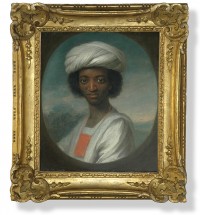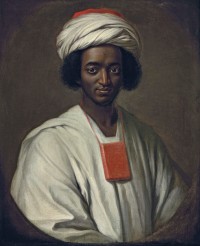 A previously unknown portrait of Ayuba Suleiman Diallo (1701–1773), an aristocrat from what is today Senegal who was sold into slavery in 1730 but made his way back home through a series of fortunate events, has been acquired by Virginia’s Jamestown-Yorktown Foundation. Along with its companion piece by the same artist, this is the earliest known portrait of a slave from the 13 colonies and the first Western portrait of a named African sitter. Its ultimate destination is the future American Revolution Museum at Yorktown which is slated to open in 2016, but it will be on display at the Yorktown Victory Center from June 14th through August 3rd.
A previously unknown portrait of Ayuba Suleiman Diallo (1701–1773), an aristocrat from what is today Senegal who was sold into slavery in 1730 but made his way back home through a series of fortunate events, has been acquired by Virginia’s Jamestown-Yorktown Foundation. Along with its companion piece by the same artist, this is the earliest known portrait of a slave from the 13 colonies and the first Western portrait of a named African sitter. Its ultimate destination is the future American Revolution Museum at Yorktown which is slated to open in 2016, but it will be on display at the Yorktown Victory Center from June 14th through August 3rd.
Ayube Diallo, also known as Job ben Solomon in England, was the scion of a wealthy family of Muslim clerics and rulers in the West African Kingdom of Futa. While on a mission to the Gambia River to barter two slaves in exchange for supplies, Diallo was kidnapped and sold into slavery himself. He told the British slavers who bought him from his Mandingo kidnappers that his family would ransom him, but when the message didn’t get to his family in time, William and Henry Hunt loaded him into the ship and sold him to a dealer in Annapolis, Maryland.
He wound up the property of one Mr. Tolsey, a tobacco farmer on Kent Island, Maryland, who first attempted to put Diallo to work in the fields. He couldn’t hack it. This was back-breaking labor, and Diallo was a soft scholar. He was assigned to tending cattle instead, which he was a little better at. After being mocked by children for his prayers, in June of 1731 Diallo ran away. He was soon captured and put in prison in the Kent County Courthouse. There he met a British lawyer named Thomas Bluett whose curiosity was piqued by Diallo’s fine carriage and composure.
Bluett enlisted a translator and found out Diallo came from a wealthy family of important people. Tolsey, keen to derive some kind of profit from this liability of a slave, allowed Diallo to write a letter back home and then gladly allowed an official from the Royal African Company in London to buy his freedom. Diallo and Bluett sailed to London in March of 1733 where the cleric, nobleman and former slave made a social splash. He was commissioned by the future founder of the British Museum, Sir Hans Sloane, to translate Arabic manuscripts in his library. He was introduced at Court by the Duke of Montagu. And he had his portrait painted by William Hoare.
Bluett describes the painting of the portrait in Some Memoirs of the Life of Job, one of the earliest slave narratives (albeit not written in first person):
JOB’s Aversion to Pictures of all Sorts, was exceeding great; insomuch, that it was with great Difficulty that he could be brought to sit for his own. We assured him that we never worshipped any Picture, and that we wanted his for no other End but to keep us in mind of him. He at last consented to have it drawn; which was done by Mr. Hoare. When the Face was finished, Mr. Hoare ask’d what Dress would be most proper to draw him in; and, upon JOB’s desiring to be drawn in his own Country Dress, told him he could not draw it, unless he had seen it, or had it described to him by one who had: Upon which JOB answered, If you can’t draw a Dress you never saw, why do some of you Painters presume to draw God, whom no one ever saw?
Hoare figured it out in the end, painting Diallo in a white robe and turban, wearing verses from the Qur’an in a pouch around his neck. The use of national dress makes this portrait unique. Other prominent named Africans would be painted after Diallo, but they were depicted wearing English dress and wigs.
 Hoare painted two versions of this portrait, although for centuries only one was known and it was long thought lost. The only evidence of it was a 1750 print. It turns out to have been in the same family since 1840 and was rediscovered in December 2009 when the owners put it up for auction at Christie’s in London. The Qatar Museums Authority purchased it for £554,937.50 ($932,517). The Culture Minister put a temporary export block on the painting to give the National Portrait Gallery a chance to raise the money by the end of August 2010. They came within £60,000 of the goal on August 12th, 2010. I was unable to discover if they actually managed to raise the full amount on time, but either way, the NPG made the QMA a purchase offer which it refused. The QMA did withdraw its export application, however, and eventually negotiated a long-term loan with the National Portrait Gallery.
Hoare painted two versions of this portrait, although for centuries only one was known and it was long thought lost. The only evidence of it was a 1750 print. It turns out to have been in the same family since 1840 and was rediscovered in December 2009 when the owners put it up for auction at Christie’s in London. The Qatar Museums Authority purchased it for £554,937.50 ($932,517). The Culture Minister put a temporary export block on the painting to give the National Portrait Gallery a chance to raise the money by the end of August 2010. They came within £60,000 of the goal on August 12th, 2010. I was unable to discover if they actually managed to raise the full amount on time, but either way, the NPG made the QMA a purchase offer which it refused. The QMA did withdraw its export application, however, and eventually negotiated a long-term loan with the National Portrait Gallery.
The publicity from the NPG’s fundraising campaign brought attention to the portrait, inspiring the owners of the second version to engage in private sale negotiations with the Jamestown-Yorktown Foundation.
The Jamestown-Yorktown Foundation, Inc., purchased the oil-on-canvas painting with funds raised privately, including a lead gift from Foundation trustee Fred D. Thompson, Jr., of Thompson Hospitality, the country’s largest minority-owned food service company. “This portrait is a powerful symbol of the diversity of colonial America’s population, which included people from many different African cultures,” says Thompson. “Diallo – his image and story – is an ideal teaching opportunity for the American Revolution Museum at Yorktown galleries.”
“For approximately three years now, the Foundation has been in confidential negotiations to acquire this important portrait,” says Thomas E. Davidson, Jamestown-Yorktown Foundation senior curator. “Diallo’s visage speaks for the hundreds of thousands of enslaved Africans and African Americans who remain largely unknown, yet who constituted a major part of late-colonial America’s population.”
How interesting that he was in the midst of bartering slaves when he became one himself. I wonder if or how his attitude toward slavery as a social convention changed after his experience.
I wondered that myself. I wasn’t able to find any specific comment on it, however.
“his Mandingo kidnappers”: I trust those pesky Mandingos are going to pay reparations.
I seriously doubt it.
He was a muslim, those slaves he was trying to sell no doubt weren’t and therefore weren’t human beings.
And muslims still think like that to this day, their religion tell them that that’s truth, and their religion can’t be ever questioned by them as such would be heresy.
So he was selling animals when infidels imprisoned him, or so he no doubt considered the events to have been…
You have incorrect information, I’m afraid. Islamic scriptures treats slavery in significant detail and slaves are clearly defined as human with certain attendant rights. One of the five pillars of Islam encourages the donation of money to free slaves, and manumission of your own slaves is one of the ways you can expiate your sins.
This is in distinct opposition to chattel slavery as practiced by American Christians who often defined Africans as animals. They created a whole pseudo-science around it, in fact.